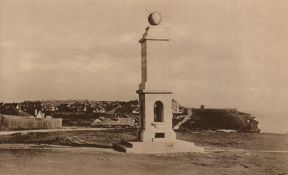The Greenwich Meridian
…where east meets west
| Location | England East Sussex Peacehaven |
| Promenade (at junction with Horsham Avenue) | |
| Distance (S) from Greenwich | |
| OS map details | OS Explorer: 122 |
| OS grid ref | TQ 40954.00806 (540954,100806) |
| WGS84 lat/long | 50.789694, -0.001610 |
| Type | Obelisk/Pillar | Ground (line) |
| Marking date | 8 Aug 1936 |
| Access | Unrestricted |
Currently viewing images from c. 1937
 |
Click to choose image set
| 15 Jul 2018 | 10 Jul 2011 | 31 May 2009 | 27 Jan 2008 | 01 Jun 2007 | 28 Jan 2006 | 17 Apr 2005 | 23 Jan 2005 | 2003_6_13 | Apr 2003 | Feb 1999 | 26 Jun 1984 | c. 1960 | 1950s | 1940s | c. 1938 | c. 1937 | 10 Aug 1936 | 1936 |
Additional picture credits
Stanley Bernard (c. 1938 & Feb 1999), Unknown (1950s, c. 1960 & 13 Jun 2003) & Evening Argus (26 Jun 1984).The town of Peacehaven was created in a somewhat controversial manner by the land agent Charles Neville, who started buying up agricultural land in late 1915. Neville had few of the worthy principles of his contemporary Ebenezer Howard whose ideas influenced the new Garden Cities at Letchworh and Welwyn. His approach was altogether more cavalier and depended for its success upon his undoubted ability to generate publicity and his willingness to take on his detractors in court. In the 1930s, it was Neville’s flair for publicity that brought the Meridian and the notion of marking it, to the attention of a wider public.
In or around 1933, one of the town’s residents, Commander WS Davenport, mentioned that the Meridian passed though the town. Realising he could turn this to his advantage, Neville asked Davenport to organise a public appeal to raise money for an obelisk complete with drinking fountain that would both mark the Meridian, and at the same time, commemorate the forthcoming Silver Jubilee of King George V.
‘A broad white strip of stonework some fifty yards long, with a groove running down the middle’ was laid along the Meridian from the Promenade right up to the cliff edge. Soon after, a temporary wooden structure with four fingerposts and details of the appeal was erected astride it. This became known locally as OTMOP (On the Meridian of Peacehaven).
The appeal was formerly launched at a special fete on 10 August 1935. Neville in the presence of invited guests and a correspondent from The Times turned the first sod, unveiled a model of the proposed memorial (designed by Mr RWH Jones), and launched a blistering attack on the many critics of his development at Peacehaven. The date coincided with the 260th anniversary of the laying of the first foundation stone of the Royal Observatory at Greenwich. All was duly reported in The Times two days later.
Although it had been intended that the obelisk should commemorate the King’s Silver Jubilee in June 1936, he died on 20 January before even the foundation stone had been laid. Ever the opportunist, Neville, decided to rename it the King George V Memorial and Prime Meridian Obelisk. The foundation stone was laid by Neville on 30 May. By the time of the unveiling, the obelisk was adorned with three plaques, all of which still survive. Harold Spencer Jones, the newly appointed Astronomer Royal was invited to give a speech at the unveiling on Saturday 8 August 1936 (the first if the images of the unveiling shows him in full flow). The occasion, which was reported in The Times on 10 August, provoking a flurry of correspondence from its readers.
The appeal had sought to raise a sum of £300. The souvenir programme contains a list of 84 named and anonymous donors, who between them gave £111.14s. The contributions ranged from 6d to £50 (from Neville). An additional anonymous donor agreed to underwrite any under-funding to the tune of £100, indicating a potential funding gap of nearly £90.
Over the years, the distance between the obelisk and the cliff edge gradually diminished as erosion took place. The obelisk was moved 30 feet to the north during work on the sea defences in the 1960s. The first phase in the construction of a new sea wall and groynes began in 1977. In August 1981, the local paper Meridian Post reported that the monument was to be moved back another 24 feet from the cliff edge, because the cliff in its vicinity was to be trimmed back as part of a new phase of the works. The second move was less straightforward than the first because the land on which the obelisk stood belonged to the town, whereas the new site belonged to Lewes District Council. Suggestions that the obelisk should be moved nearer the Meridian Centre were apparently considered, but rejected because the town’s logo shows it on the cliff top and, because it was also regarded as a maritime navigation aid. When the fence on the edge of the cliff was replaced in 2005, it was moved about 3 feet closer to the obelisk.
The obelisk was the focus of the town’s celebrations when the ‘centenary’ of the Meridian was commemorated in 1984. When HRH The Princess Margaret was unable to accept a somewhat belated invitation to unveil a new commemorative plaque on 23 June, the Mayor, Councillor Alfa Clayton unveiled it on 26 June as originally planned. It has since been moved from above the list of capitals of the Empire on the north side to its present position on the south.
The obelisk was damaged in the storms of 1987 when the globe on its top was lost to the sea. It has since been replaced.


